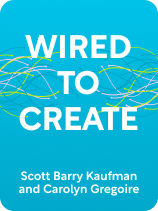

This article is an excerpt from the Shortform book guide to "Wired to Create" by Scott Barry Kaufman and Carolyn Gregoire. Shortform has the world's best summaries and analyses of books you should be reading.
Like this article? Sign up for a free trial here.
What does mindfulness have to do with creativity? What are the two most important characteristics of creativity?
It may seem like a contradiction, but both daydreaming and mindfulness are important for creativity. Mindfulness allows you to quiet your inner monologue and enter into the flow state.
Keep reading to learn how creativity and mindfulness are linked.
Creative Mindfulness
How are creativity and mindfulness connected? In the book Wired to Create, a characteristic the authors say creatives share is mindfulness. The authors define mindfulness as the ability to pay attention to the finer details of life in both your outer and inner world—for example, noticing the bumps and ridges on a tree’s bark or the way you feel when you watch a certain part of a movie.
The authors explain that the combination of daydreaming and mindfulness seems contradictory but is the perfect formula for creativity. Daydreaming allows your mind to think about and notice many different things, and mindfulness allows you to hone your focus and elicit meaning from things you find particularly impactful. The combination of these two characteristics is the formula for finding meaning in life and developing insights into the human experience—the two main drives that encourage creative people to create.
| The Neuroscience Behind Creativity In A Mind for Numbers, Barbara Oakley explains why switching between daydreaming and mindfulness is key to problem-solving and creativity. When we’re being mindful—what Oakely refers to as using the focused mode of thinking—our thoughts travel more quickly along shorter neural pathways that link familiar and related concepts, allowing us to retrieve information about related concepts easily. This is effective for making detailed observations, solving simple problems, or doing work you’re familiar with; however, it prevents you from coming up with unique insights or solutions that exist outside of that cluster of related concepts. On the other hand, when we’re daydreaming—or in Oakley’s terms, using the diffuse mode of thinking—our thoughts traverse longer neural pathways between more diverse, unrelated concepts. This allows us to subconsciously process information gathered during sessions of focused mode thinking and make connections between previously unrelated concept clusters. So to maximize your creativity and problem-solving ability, Oakley recommends actively switching between focused and diffuse modes of thinking—the more you do so, the more unique insights and connections you’ll make. |
Further, the authors explain that practicing mindfulness trains us to control and direct our attention—focusing on specific elements teaches us to quiet our inner monologue and control thoughts that might disrupt our focus. This facilitates creativity because it allows us to more easily enter and maintain a state of flow.
(Shortform note: In That Little Voice In Your Head, Gawdat refers to mindfulness as “deliberate attention” and reiterates that practicing it allows you to have more control of your thoughts and more easily enter flow. However, to achieve these effects, you must intentionally practice it every day. To do so, Gawdat recommends going about your day actively observing the world around you and choosing to look for positivity and beauty. Not only will this help you direct your attention, but you’ll notice beautiful things in your everyday life that you may have overlooked otherwise. This will make you a happier person and may even inspire creative insights.)

———End of Preview———
Like what you just read? Read the rest of the world's best book summary and analysis of Scott Barry Kaufman and Carolyn Gregoire's "Wired to Create" at Shortform.
Here's what you'll find in our full Wired to Create summary:
- What creativity truly means—and why it’s hard to define
- The 10 characteristics of creative people
- How to maximize your creative potential






